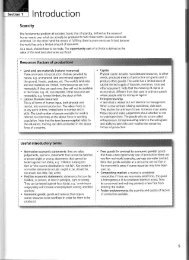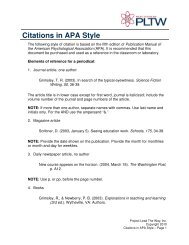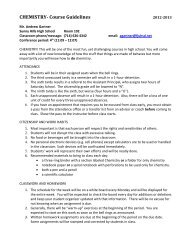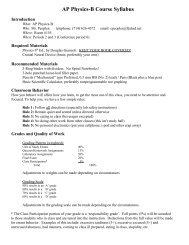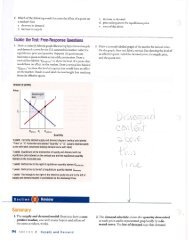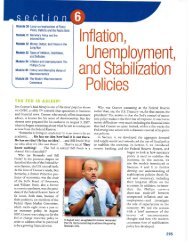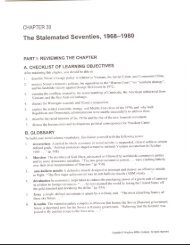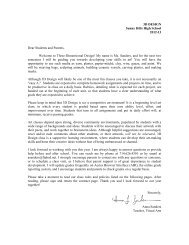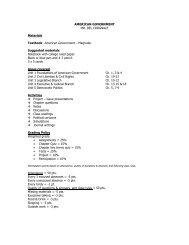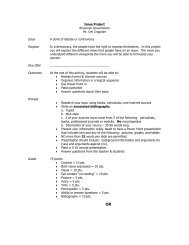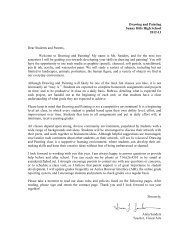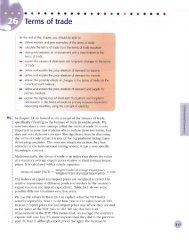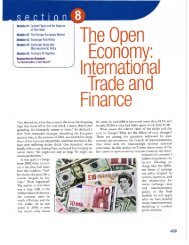IB Econ Study Guide Internationals - Sunny Hills High School
IB Econ Study Guide Internationals - Sunny Hills High School
IB Econ Study Guide Internationals - Sunny Hills High School
Create successful ePaper yourself
Turn your PDF publications into a flip-book with our unique Google optimized e-Paper software.
Why do exchange rates<br />
Factors that may affect trade flows: changes in relative<br />
inflation rates<br />
. lf inflation in a country accelerates it means that prices in<br />
that country are rising on average fasler than they dld. As<br />
a result its products will become less and less competitive<br />
aDroao.<br />
. lts exports will decrease and so will the demand for its<br />
currency in foreign exchange markets. ln addition, foreign<br />
products (imports) will now seem relatively more attractive<br />
to domestic househo ds. lmport spending will tend to rise<br />
and thus supply of iG currency in foreign exchange markets<br />
(as they will need more dollars to pay for these imports).<br />
. Figure 4.12 illustrates the effect of higher inflation in<br />
lndonesia on its currency, the rupiah. Initially the rupiah is<br />
valued against the dollar at e7.<br />
. The higher inflation in Indonesia will have an adverse<br />
effect on its exports as they will become less competitive<br />
abroad and thus decrease. decreasing the demand for the<br />
rupiah from D1 to D2.<br />
. At the same time inflation will make Indonesians find<br />
foreign products more and more attradive. lmporls will<br />
tend to increase and thus more rupiahs wlll be supplied in<br />
the foreign exchange market, shifting the supply of rupiahs<br />
from 51 to 52. The rupiah wlll tend to depreciate to e2.<br />
. Inflatlon in an economy will tend to depreciate a currency.<br />
Figure 4.12 Effect of higher inflation on the exchange rate<br />
-E FE<br />
may be constrained. Many economies limit the types of<br />
foreign investment flows they permit as some of these<br />
investments may prove very destabilizing. Short-term<br />
speculative capital may suddenly be withdrawn leading to<br />
a sudden sharp depreciation and consequently to adverse<br />
real effects on the economy. There rs a lot of discussion<br />
on the desirability of such private capital inflows especially<br />
for developing countries.<br />
Factors that may affect investment tlows: changes in relative<br />
interest lates<br />
. lf interest rates in a country decrease then domestic bonds<br />
as well as savings deposits in the domestic currency will<br />
be less attractive to foreign investors as they will earn less<br />
on their financial investments.<br />
. As a result not only will demand for that currency decrease<br />
as there will be less demand for that country's bonds, but<br />
also there will be an increase in the supply of that countryS<br />
currency as investors will sell that currency to buy currency<br />
and bonds of other countries. The effect of lower interest<br />
rates will be a tendenry for the currency to depreciate.<br />
. In Fig. 4.13 we assume that the dollar price of the euro<br />
is inilially at e 7. Let the European Central Bank decrease<br />
interest rates. Now the rate of return on European bonds<br />
as well as on deposits in euros is lower so these assets will<br />
be less attractive to investors.<br />
. Demand for the euro will decrease from D1 to D2 reflecting<br />
the lower demand for European bonds and euro deposits.<br />
. Also, some holders of such assets will decide to sell them,<br />
: .6<br />
E99'<br />
!4E"'<br />
51 of<br />
(M1)<br />
Rupiah<br />
(M2 > M1)<br />
increasing the supply of euros from s1 to s2 as they will<br />
switch to more attract ve bonds issued by other countries.<br />
The euro will tend to depreciate from e/ to e2.<br />
. A note of caution here: if interest rates rise there will be<br />
a tendency for the exchange rate to appreciate, assum,hg<br />
that foreign inveslors do not exoect the cLrrency to<br />
depreciate. For example if interest rates in country A<br />
rise then investors will not flock into that country if they<br />
expect its currency to depreciate. 50 interest rates do<br />
matter but so does the expectation about the future path<br />
of the exchange rate itself.<br />
(x2 <<br />
Rupiah traded Per Period<br />
Factors that may affect investment (capital) flows<br />
. lnvestment flows are also referred to as capital flows and<br />
lnclude porffolio investments (the buying and selling of<br />
bonds, stocks and other financial assets) and FDI (foreign<br />
direct jnvestment which refers to investors establishing a<br />
presence in a foreign country eilher by setting up a new<br />
firm or by acqulring a controlling share of an existing<br />
domestic firm).<br />
. l\y'uch of these capital flows are shorl term and specuiative<br />
in nature. Currency speculation is also included in this<br />
section. These transactions are included ln the capital<br />
account of the balance of payments of a country<br />
. Bear in mind that not all countries have fully liberalized<br />
their capital account. Thrs means that foreign investment<br />
Figure 4.13 Effect of lower interest rates on the exchange rate<br />
EE<br />
E<br />
g<br />
Sl for euros<br />
52 for euros<br />
in EUl s)<br />
D1 for euros<br />
in EU15)<br />
D2 Jor euros<br />
(when r = 12 < rl in EU15)



